Iodine number of wool: A method for determining the action of various chemical reagents on wool and other proteins
引用次数: 1
Abstract
The purpose of this research was to find a method for determining the action of various chemical reagents upon wool. The iodine number provides a qualitative measure of the extent to which the amino groups are affected by various treatments of the protein. Amino acids and proteins exhibit iodine numbers as determined by the standard method. The iodine numbers of such substances do not indicate ordinary unsaturation but are shown to be related to the free amino nitrogen content. The iodine numbers of some typical proteins are reported and a general correspondence between the iodine numbers and the isoelectric points of the proteins is shown. Conversion of amino groups to hydroxyl groups, combination of amino groups with strong acids, and other chemical reactions which affect the amino groups reduce the iodine numbers of amino acids (with the exception of cysteine) to zero. Part of the iodine number of wool is shown to be due to cysteine which is very susceptible to oxidation. The iodine number of wool is therefore affected by reactions of chemical reagents with the amino or the cysteine groups. This method will distinguish, for example, between reversibly adsorbed and chemically combined acid. The latter can be removed by the action of an alkali and this restores the original iodine number of the wool.羊毛碘值:测定各种化学试剂对羊毛和其他蛋白质作用的方法
本研究的目的是寻找一种测定各种化学试剂对羊毛的作用的方法。碘值提供了对蛋白质的各种处理对氨基的影响程度的定性度量。氨基酸和蛋白质表现出用标准方法测定的碘值。这类物质的碘值并不表示一般的不饱和,而是与游离氨基氮含量有关。本文报道了一些典型蛋白质的碘值,并指出了它们的碘值与等电点之间的一般对应关系。氨基向羟基的转化,氨基与强酸的结合,以及其他影响氨基的化学反应使氨基酸(半胱氨酸除外)的碘值降至零。羊毛的碘含量部分是由于半胱氨酸,它很容易被氧化。因此,羊毛的碘值受到化学试剂与氨基或半胱氨酸基团反应的影响。例如,这种方法可以区分可逆吸附酸和化学结合酸。后者可以通过碱的作用去除,从而恢复羊毛的原始碘值。
本文章由计算机程序翻译,如有差异,请以英文原文为准。
求助全文
约1分钟内获得全文
求助全文

 求助内容:
求助内容: 应助结果提醒方式:
应助结果提醒方式:


